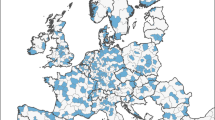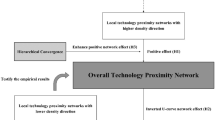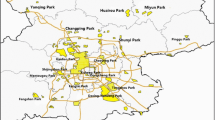Abstract
We analyze whether proximity effect, preferential attachment and path dependence or three “P” mechanisms would concur within the evolutionary process of inter-regional network. Using a unique database of China’s technology transaction between regions, we show that proximity effect, preferential attachment and path dependence have coexisted in the evolutionary process of China’s inter-regional network of technology transactions. In particular, the inter-regional relations positively and significantly correlate with the geographical and economic proximity matrix, all regions’ three centrality values in current year positively and significantly correlate with their centrality in the last two years, and the inter-regional relations in current year positively and significantly correlate with own relations in last two years. This paper contributes to the existing literature by identifying three evolutionary mechanisms of inter-regional network. An interpretation is that the evolution process of inter-regional network is a very complex process, and one mechanism such as geographical proximity from the perspective of economic geography or preferential attachment from the perspective of network science only could explain a part of the process.


Similar content being viewed by others
References
Abbasi, A., Hossain, L., & Leydesdorff, L. (2012). Betweenness centrality as a driver of preferential attachment in the evolution of research collaboration networks. Journal of Informetrics, 6(3), 403–412.
Agrawal, A., Kapur, D., & McHale, J. (2008). How do spatial and social proximity influence knowledge flows? Evidence from patent data. Journal of Urban Economics, 64(2), 258–269.
Amesse, F., & Cohendet, P. (2001). Technology transfer revisited from the perspective of the knowledge based economy. Research Policy, 30(9), 1459–1478.
Arthur, W. B. (1989). Competing technologies, increasing returns, and lock-in by historical events. The Economic Journal, 99(394), 116–131.
Balland, P., Boschma, R., & Frenken, K. (2015). Proximity and Innovation: From statics to dynamics. Regional Studies, 49(6), 907–920.
Barabási, A. L. (2012). Network science: Luck or reason. Nature, 489(7417), 507–508.
Barabási, A. L., & Albert, R. (1999). Emergence of scaling in random networks. Science, 286(5439), 509–512.
Barrat, A., Barthélemy, M., & Vespignani, A. (2005). The effects of spatial constraints on the evolution of weighted complex networks. Journal of Statistical Mechanics: Theory and Experiment, 2005(05), P05003.
Belussi, F., Sammarra, A., & Sedita, S. R. (2010). Learning at the boundaries in an “Open Regional Innovation System”: A focus on firms’ innovation strategies in the Emilia Romagna life science industry. Research Policy, 39(6), 710–721.
Boschma, R. (2005). Proximity and innovation: A critical assessment. Regional Studies, 39(1), 61–74.
Boschma, R. A., & Frenken, K. (2006). Why is economic geography not an evolutionary science? Towards an evolutionary economic geography. Journal of Economic Geography, 6(3), 273–302.
Boschma, R., & Frenken, K. (2010). The spatial evolution of innovation networks. A proximity perspective. In R. Boschma & R. Martin (Eds.), The handbook of evolutionary economic geography. Cheltenham Glos: Edward Elgar Publishing.
Boschma, R., & Iammarino, S. (2009). Related variety, trade linkages, and regional growth in Italy. Economic Geography, 85(3), 289–311.
Boschma, A. R., & Ter Wal, L. J. A. (2007). Knowledge networks and innovative performance in an industrial district: the case of a footwear district in the South of Italy. Industry and Innovation, 14(2), 177–199.
Bottazzi, L., & Peri, G. (2003). Innovation and spillovers in regions: Evidence from European patent data. European Economic Review, 47(4), 687–710.
Breschi, S., & Lissoni, F. (2001). Localised knowledge spillovers vs. innovative milieux: Knowledge “tacitness” reconsidered. Papers in Regional Science, 80(3), 255–273.
Broekel, T., & Boschma, R. (2012). Knowledge networks in the Dutch aviation industry: The proximity paradox. Journal of Economic Geography, 12(2), 409–433.
Cantner, U., & Graf, H. (2006). The network of innovators in Jena: An application of social network analysis. Research Policy, 35(4), 463–480.
Capello, R. (2009). Spatial spillovers and regional growth: A cognitive approach. European Planning Studies, 17(5), 639–658.
Capello, R., & Caragliu, A. (2012). Proximities and the intensity of scientific relations: synergies and nonlinearities. Paper presented at the Tinbergen Institute, Amsterdam, May 7–8. http://www.grupposervizioambiente.it/aisre_sito/doc/papers/Caragliu_Cappello.pdf
Cheyre, C., Klepperdeceased, S., & Veloso, F. (2015). Spinoffs and mobility of U.S. merchant semiconductor inventors. Management Science, 61(3), 487–506.
Cohen, W. M., & Levinthal, D. A. (1990). Absorptive capacity: A new perspective on learning and innovation. Administrative Science Quarterly, 35(1), 128–152.
Cooke, P., Uranga, M. G., & Etxebarria, G. (1997). Regional innovation systems: Institutional and organisational dimensions. Research Policy, 26(4), 475–491.
Cowan, R., & Gunby, P. (1996). Sprayed to death: path dependence, lock-in and pest control strategies. The Economic Journal, 106(436), 521–542.
David, A. P. (1985). Clio and the Economics of QWERTY. The American Economic Review, 75(2), 332–337.
Ejermo, O., & Karlsson, C. (2006). Interregional inventor networks as studied by patent coinventorships. Research Policy, 35(3), 412–430.
Fitjar, R. D., & Rodriguez-Pose, A. (2011). When local interaction does not suffice: sources of firm innovation in urban Norway. Environment and Planning A, 43(6), 866–884.
Florida, R. (1995). Toward the learning region. Futures, 27(5), 527–536.
Freeman, L. C. (1979). Centrality in social networks conceptual clarification. Social Networks, 1(3), 215–239.
Frenken, K., Hoekman, J., Kok, S., Ponds, R., van Oort, F., & van Vliet, J. (2009). Death of distance in science? A gravity approach to research collaboration. In A. Pyka & A. Scharnhorst (Eds.), Innovation networks: New approaches in modelling and analyzing. Berlin: Springer.
Fromhold-Eisebith, M. (2004). Innovative milieu and social capital—Complementary or redundant concepts of collaboration-based regional development? European Planning Studies, 12(6), 747–765.
Gao, X., Guan, J., & Rousseau, R. (2011). Mapping collaborative knowledge production in China using patent co-inventorships. Scientometrics, 88(2), 343–362.
Gertler, M. S., & Levitte, Y. M. (2005). Local nodes in global networks: The geography of knowledge flows in biotechnology innovation. Industry and Innovation, 12(4), 487–507.
Grabher, G., & Ibert, O. (2006). Bad company? The ambiguity of personal knowledge networks. Journal of Economic Geography, 6(3), 251–271.
Guan, J., Zhang, J., & Yan, Y. (2015). The impact of multilevel networks on innovation. Research Policy, 44(3), 545–559.
Guimera, R., & Amaral, L. A. N. (2004). Modeling the world-wide airport network. The European Physical Journal B-Condensed Matter and Complex Systems, 38(2), 381–385.
Hassink, R., & Klaerding, C. (2012). The end of the learning region as we knew it; towards learning in space. Regional Studies, 46(8), 1055–1066.
Herstad, S. J., Aslesen, H. W., & Ebersberger, B. (2014). On industrial knowledge bases, commercial opportunities and global innovation network linkages. Research Policy, 43(3), 495–504.
Hoekman, J., Frenken, K., & Tijssen, R. J. (2010). Research collaboration at a distance: Changing spatial patterns of scientific collaboration within Europe. Research Policy, 39(5), 662–673.
Hoekman, J., Frenken, K., & van Oort, F. (2009). The geography of collaborative knowledge production in Europe. The Annals of Regional Science, 43(3), 721–738.
Katz, J. (1994). Geographical proximity and scientific collaboration. Scientometrics, 31(1), 31–43.
Krätke, S. (2010). Regional knowledge networks: A network analysis approach to the interlinking of knowledge resources. European Urban and Regional Studies, 17(1), 83–97.
LeSage, J. P., Fischer, M. M., & Scherngell, T. (2007). Knowledge spillovers across Europe: Evidence from a Poisson spatial interaction model with spatial effects. Papers in Regional Science, 86(3), 393–421.
Liu, H., & Jiang, Y. (2001). Technology transfer from higher education institutions to industry in China: Nature and implications. Technovation, 21(3), 175–188.
Lundvall, B. A. (1992). National systems of innovation: An analytical framework. London: Pinter.
Ma, H., Fang, C., Pang, B., & Li, D. (2014). The effect of geographical proximity on scientific cooperation among Chinese cities from 1990 to 2010. PLoS One, 9(11), e111705.
Ma, R., Liu, F., & Sun, Y. (2013). Collaboration partner portfolio along the growth of Chinese firms’ innovation capability: Configuration, evolution and pattern. International Journal of Technology Management, 62(2/3/4), 152–176.
Maggioni, M. A., & Uberti, T. E. (2009). Knowledge networks across Europe: Which distance matters? The Annals of Regional Science, 43(3), 691–720.
Maggioni, M. A., Uberti, T. E., & Usai, S. (2011). Treating patents as relational data: Knowledge transfers and spillovers across Italian provinces. Industry and Innovation, 18(1), 39–67.
Martin, R., & Sunley, P. (2006). Path dependence and regional economic evolution. Journal of Economic Geography, 6(4), 395–437.
Mathieu, E. J., Heffner, S. T., Goodwin, F. G., Salas, E., & Cannon-Bowers, A. J. (2000). The influence of shared mental models on team process and performance. Journal of Applied Psychology, 85(2), 273–283.
Morescalchi, A., Pammolli, F., Penner, O., Petersen, A. M., & Riccaboni, M. (2015). The evolution of networks of innovators within and across borders: Evidence from patent data. Research Policy, 44(3), 651–668.
Morgan, K. (2004). The exaggerated death of geography: Learning, proximity and territorial innovation system. Journal of Economic Geography, 4(1), 3–21.
Orsenigo, L., Pammolli, F., & Riccaboni, M. (2001). Technological change and network dynamics: Lessons from the pharmaceutical industry. Research Policy, 30(3), 485–508.
Porter, M. E. (1994). The role of location in competition. Journal of the Economics of Business, 1(1), 35–39.
Porter, M. E. (1998). Clusters and the new economics of competition. Harvard Business Review, 76(6), 77–90.
Scott, J. (1991). Social network analysis: A handbook. London: Sage Publications.
Sebestyén, T., & Varga, A. (2013). Research productivity and the quality of interregional knowledge networks. The Annals of Regional Science, 51(1), 155–189.
Sun, Y., & Cao, C. (2015). Intra-and inter-regional research collaboration across organizational boundaries: Evolving patterns in China. Technological Forecasting and Social Change, 96(7), 215–231.
Wang, Y., Pan, X., Ning, L., Li, J., & Chen, J. (2015). Technology exchange patterns in China: An analysis of regional data. The Journal of Technology Transfer, 40(2), 252–272.
Wang, Z. Z., & Zhu, J. J. (2014). Homophily versus preferential attachment: Evolutionary mechanisms of scientific collaboration networks. International Journal of Modern Physics C, 25(05), 1440014.
Wanzenböck, I., Scherngell, T., & Brenner, T. (2014). Embeddedness of regions in European knowledge networks: A comparative analysis of inter-regional R&D collaborations, co-patents and co-publications. The Annals of Regional Science, 53(2), 337–368.
Wennekers, S., Van Wennekers, A., Thurik, R., & Reynolds, P. (2005). Nascent entrepreneurship and the level of economic development. Small Business Economics, 24(3), 293–309.
Zhang, G., Duan, H., & Zhou, J. (2016). Investigating determinants of inter-regional technology transfer in China: A network analysis with provincial patent data. Review of Managerial Science, 10(2), 345–364.
Acknowledgments
This work has been supported by the National Natural Science Foundation of China (71203020), the EU 7th Framework Programme–Marie Curie International Incoming Fellowship (302303/911303), the Fundamental Research Funds for the Central Universities (DUT15ZD111) and Liaoning Science and Technology Plan Projects (2015401039).
Author information
Authors and Affiliations
Corresponding author
Rights and permissions
About this article
Cite this article
Sun, Y., Liu, K. Proximity effect, preferential attachment and path dependence in inter-regional network: a case of China’s technology transaction. Scientometrics 108, 201–220 (2016). https://doi.org/10.1007/s11192-016-1951-0
Received:
Published:
Issue Date:
DOI: https://doi.org/10.1007/s11192-016-1951-0




